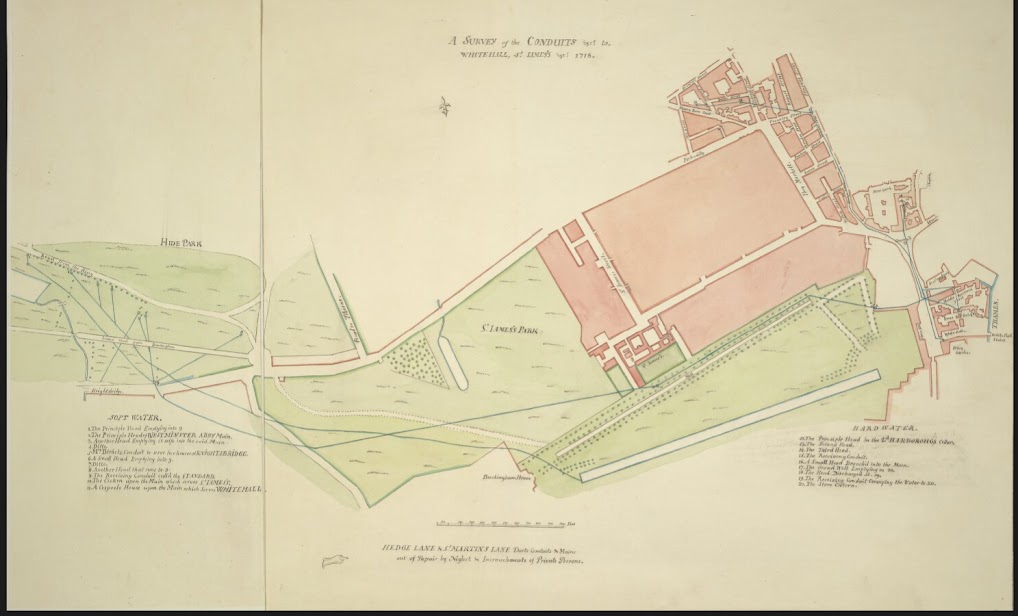Queen Elizabeth's Bath by the King's Mews.
Actually at the West end of Frontier Court, off the West side of St Martin's Lane, just East of the Little Mews.
The land was occupied by builders Haward and Nixon.
James Hawood and William Thomas Nixon
Anonymous drawing.
Image courtesy Museum of London.
Queen Elizabeth's Bath formerly stood among a cluster of old buildings adjoining the King's Mews at Charing Cross, and was removed in 1831 along with the Kings Mews the North side of Charing Cross and the South end of St Martin's Lane for the improvements and construction of Trafalgar Square.
Of this Bath a plan and view were presented to the Society of Antiquaries, February 9, 1832, and are engraved in the " Archasologia," xxv. 588-90. (above).
The building on the plan was nearly square, and was constructed of fine red brick. Its chief merit consisted in its groined roof, which was of very neat workmanship, and formed by angular ribs springing from corbels.
The form of the arch denoted the date of this building to be the fifteenth century. —
See Timbs's Curiosities of London, 1868, p. 39.
........................
Gentleman's Magazine Ref.
...............................
Detail from a Plan of the Kings Mews.
This undated plan must have been prepared before the rebuilding of the stables designed by William Kent in 1732.
............................
Queen Elizabeth's Bath within the premises of Messrs Hayward and Nixon.
at the West end of Frontier Court off St Martin's Lane.
Plan of 1830.
The purchase of the inn (The Golden Cross) at the time of these improvements was by far the largest that the Commissioners had to make. It was concluded on December 28, 1827, when the extensive premises, with three houses in St. Martin's Lane and two houses and workshops in Frontier Court, were bought of George Howard and others for the sum of £3o,ooo.
Nos. 142 to 147, St. Martin's Lane, were also sold by the Bethlem Hospital to the Crown in 1830. They were then let to George Boulton. Nos. 137
to 141, St. Martin's Lane, some houses in Frontier Court and Haward and Nixon's
premises in the rear occupied the remainder of the ground on the 1649
plan and were sold by Haward's descendants to the Crown in 1827.
In 1816 W Head Plumber was at 141 St Martins Lane - Post Office Directory.(available and searchable on line) - very useful for locating businesses in London in 1816.
https://babel.hathitrust.org/cgi/pt?id=hvd.32044098323918&seq=7
The 1649 Plan.
https://www.british-history.ac.uk/survey-london/vol20/pt3/pp7-14
Entrance to Frontier Court underneath the premises of S. Wolf, Taylor.
............................
Anonymous drawing from the Museum of London
I suspect a copy of a drawing by George Scharf.
............
View of the courtyard of 139 St Martin's Lane, Charing Cross - Haward &
Nixon's premises. A view of a yard, with an office door.
Looking west.
Anonymous Drawing courtesy Museum of London.
prior to 1830.
.............................
Hayward and Nixon's Premises in Frontier Court viewed from a back window of a house on the West side of St Martin's Lane, pre 1830.
https://www.britishmuseum.org/collection/object/P_1862-0614-100
Messrs Hayward and Nixon subsequently relocated to 18 Old Quebec Street, Stangate, Lambeth.
St Martin's Northern Schools. 1850. - Illustrated
London News, 19 October 1850, p. 312.
A sermon was preached on Thursday, by the Bishop of London,
in St. Martin's Church, for the purpose of inaugurating the St. Martin's
Northern Schools. These have been erected in Castle-street, Long-acre; the
architect being Mr. James William Wild, and the builders Messrs. Haward and
Nixon, at the expense of £2433.
.................................
James Fraser, 1740 - c.1813. Bookbinder.
4, White Hart Court, Castle Street, Leicester Fields. (behind Peters Court) Prior to 1779.
1, Frontier Court, No.139 St Martin's Lane (1802). (1782). Later Fraser and Son.
139 St Martin's Lane.
84, St. Martin's Lane.
James Fraser Trade Card.
1793.
Engraved by Walker
British Museum.
https://www.britishmuseum.org/collection/object/P_D-2-542
.........................
Fraser's avuncular appearance belied his reputation as a stern taskmaster; in 1786 he became notorious for joining other bookbinding masters in a combination that prosecuted five journeymen bookbinders who were attempting to reduce their working day, which lasted from 6 am to 8 pm with a half hour break for breakfast and one hour for lunch.
The journeymen lost their
case and were jailed for two years. Source: Jonathan E. Hill, 'In a Bind',
Electronic British Library Journal, 2014, article 17.
Extract above from BM website.
In this portrait, master bookbinder James Fraser (1740-after
1813) of St. Martin’s Lane holds a paper headed, “A Plan for reconciling the
difference between the Masters and Journeymen Bookbinders.” On the table are
three books: Memoirs of Mr. Pitt, Estimates of Bookbinders, and Anecdotes of
Lord Nelson, along with the newspaper The Oracle, May 28 1802.
These elements refer to Fraser’s his role as one of three
“Prosecuting Masters” in the 1786 trade dispute among bookbinders. He described
the costs of binding different types of books and advocated a piece-rate method
of working, rather than the customary fixed weekly wage. One request was to
reduce the work day from 14 hours to 13 hours. A strike, a trial and
imprisonment of five men followed.
Images and information above from
https://graphicarts.princeton.edu/2015/07/13/the-difference-between-bookbinders/
...................
Trade Card of Fraser and Son.
Removed to 84 St Martins Lane.
https://www.britishmuseum.org/collection/object/P_Heal-16-19
............................................
Thomas Harris, Cabinet Maker.
2 Frontier Ct, St Martin's Lane, London, c (1786).
Took out a Sun Insurance policy on 31 July 1786 for £100, £20
accounting for utensils. [GL, Sun MS vol. 338, p. 231]
https://bifmo.furniturehistorysociety.org/entry/harris-thomas-1786..
Moon's Tool Warehouse, 145 St Martin's Lane.
......................................
The Adventures of Jack Wonder written by himself.
London : printed for T. Jones, at his circulating library,
in Great May's-Buildings, St. Martin's-Lane, 1766?
























